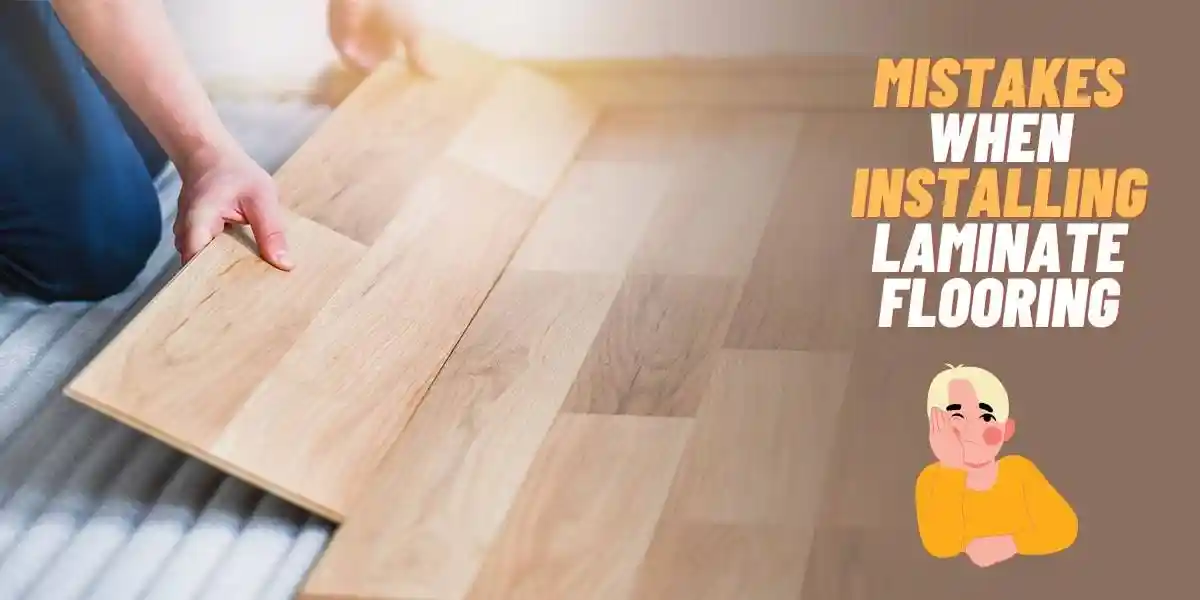We’ve all been there – that ambitious DIY project that seems like a piece of cake. Until it’s time to put the pieces together.
Laminate flooring, with its affordability and easy installation, is a popular choice for many home improvement enthusiasts. But, what seems like a straightforward task can quickly turn into a headache if you’re not careful.
Thus, we’re going to unravel the common mistakes that folks often stumble upon when laying laminate flooring.
We won’t just point fingers; we’ll also explore why these mistakes happen in the first place. Understanding the pitfalls can help you sidestep them. And achieve the perfect laminate floor you’ve been dreaming of.
So, grab your measuring tape, and let’s navigate through the dos and don’ts of laminate flooring installation. After all, a little knowledge can save you from a lot of headaches down the DIY road.
One of the most common mistakes people make when laying laminate flooring is not taking the time to measure their flooring. It will lead to uneven floors or gaps between planks, which look unsightly.
It’s also important to make sure you buy enough laminate planks for your space. To avoid running out of materials before completing the installation.
Likewise, if you intend to install laminate flooring on your own. Read this blog post to avoid common mistakes when laying laminate flooring.
You Might Also Like:
- Can You Nail Down Laminate Flooring? (Answered)
- Does Laminate Flooring Make Your House Colder? (Explained)
13 Mistakes to Avoid When Laying Laminate Flooring
1. Skipping the Acclimation Period
Before diving into laminate flooring, let the planks chill in the room for a bit. It’s like giving them time to adjust to the room’s vibe.
Skipping this step is like expecting someone to perform without a warm-up. The planks might get all bent and out of shape later on.
2. Neglecting Subfloor Preparation
Treat your subfloor right. Clean it, make it flat, and declutter. If you don’t, your floor could end up as bumpy as a rocky road, and it might start making noises like an old creaky door.
Also, remove any nails and screws from the floor. It may sound like a daunting task. But it is one of the most important steps. Because if you don’t prepare the floor properly, laminate flooring will start to buckle or shift.
3. Rushing Through Installation
Impatience can be your worst enemy during laminate flooring installation. Rushing through the process can result in misaligned planks, uneven seams, and an overall shoddy finish.
4. Inadequate Expansion Gaps
Laminate needs room to breathe. Make sure to leave enough expansion gaps around the perimeter. If not your laminate flooring might end up buckling. As it expands due to changes in temperature and humidity.
5. Making Mistakes at the Corners and Seams
One of the most common mistakes people make when laying laminate flooring is not aligning the planks correctly. Make sure your planks are cut at a 45-degree angle, then firmly butted together.
Besides, if you need to trim a few inches off one end of the board, make sure it is aligned with the other. When installing notches and corners, you should glue them. To ensure the boards fit snugly together.
Also See: 7 Best Ways to Fix Peeling Laminate Floor (Must-Try!)
6. Disregarding Manufacturer Recommendations
Every laminate brand has its rules book. Don’t play the game without reading it, or you might lose your warranty or mess up the whole setup. Check what the brand says – they know their stuff.
Also, if you’re thinking about installing laminate flooring yourself. At least hire a professional to help walk you through the proper steps.
It’s important to have an expert come in to do this job. Because they know which flooring is best for your home and how to install it.
7. Poor Underlayment Choice
The underlayment is like a mattress for your floor. Choose the wrong one, and your floor won’t feel right. Follow the guidelines for the right underlayment for a happy, comfy floor.
To avoid this problem, prepare your subfloor in advance. Install an underlayment before installing laminate flooring.
An underlayment works by absorbing shocks and pressure from walking on the floor. Apart from that, it evens out small irregularities on your floor.
You Might Also Like:
- Cork vs. Foam Underlayment: Which One Should I Choose?
- Cork vs. Rubber Underlayment: Which One Should I Choose?
8. Ignoring Moisture Issues
Moisture and laminate are like oil and water. Sort out any water problems before you start, or your floor might turn into a moldy, moody mess. Keep it dry, keep it happy.
Remove any standing water and use a dehumidifier if you live in a humid area. Make sure the room is ventilated and use fans to circulate the air. Use an anti-mold treatment to keep your floor healthy.
Must See: How to Dry Water Under Laminate Flooring? (A Step-By-Step Approach)
9. Using the Wrong Tools
Trying to cut corners with the wrong tools can lead to chipped or damaged laminate. Invest in the proper tools, including a saw designed for laminate flooring.
Make sure to read the instructions for the saw and learn how to use it properly. Wearing safety goggles and a face mask is also recommended. Finally, be careful not to overcut the material, as this can cause the laminate to crumble.
10. Not Using a Vapor Barrier
It is not recommended to install laminate flooring without a vapor barrier. A vapor barrier is a thin plastic sheet placed between the subfloor and laminate flooring.
Vapor barriers are necessary to prevent moisture from getting into the subfloor. If moisture gets into the subfloor, it can cause mold, rot, and damage to your home.
11. Rushing Through Installation
Impatience can be your worst enemy during laminate flooring installation. Rushing through the process can result in misaligned planks, uneven seams, and an overall shoddy finish.
12. Incorrect Undercutting of Door Jambs
Doors need love too. Cutting door jambs properly ensures a smooth transition between rooms. Don’t rush this step, or you might end up with awkward gaps, like trying to fit a square peg into a round hole.
Take the time to measure and cut the jambs with precision. It will make the job easier and the finished product will look much better. If done correctly, it will last for years to come.
13. Forgetting to Tap Planks into Place
Neglecting to tap the planks into place with a tapping block can result in uneven seams and gaps. Use the appropriate tools to ensure each plank locks securely to its neighbors.
Start with the joints and make sure each plank is secured before going on to the next.
Check the seams for any gaps and fill them with caulking if necessary. Finally, use a level to check the surface and make sure it is even.
Read More on Laminate Floors
- Can You Nail Down Laminate Flooring? (Answered)
- How to Fix Side Gaps in Laminate Flooring? (5 Best Ways)
- Can I Use Laminate Flooring On Walls? (Installation Guide Included)
- Can You Put Laminate Flooring Over Ceramic Tile? (A Comprehensive Guide)
- How to Dry Water Under Laminate Flooring? (A Step-By-Step Approach)





